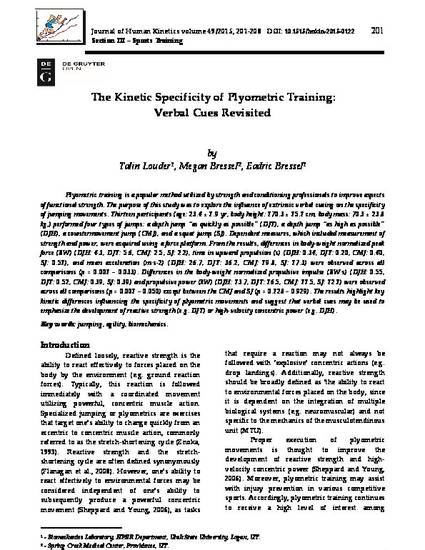
Plyometric training is a popular method utilized by strength and conditioning professionals to improve aspects of functional strength. The purpose of this study was to explore the influence of extrinsic verbal cueing on the specificity of jumping movements. Thirteen participants (age: 23.4 ± 1.9 yr, body height: 170.3 ± 15.1 cm, body mass: 70.3 ± 23.8 kg,) performed four types of jumps: a depth jump “as quickly as possible” (DJT), a depth jump “as high as possible” (DJH), a countermovement jump (CMJ), and a squat jump (SJ). Dependent measures, which included measurement of strength and power, were acquired using a force platform. From the results, differences in body-weight normalized peak force (BW) (DJH: 4.3, DJT: 5.6, CMJ: 2.5, SJ: 2.2), time in upward propulsion (s) (DJH: 0.34, DJT: 0.20, CMJ: 0.40, SJ: 0.51), and mean acceleration (m·s-2) (DJH: 26.7, DJT: 36.2, CMJ: 19.8, SJ: 17.3) were observed across all comparisons (p = 0.001 - 0.033). Differences in the body-weight normalized propulsive impulse (BW·s) (DJH: 0.55, DJT: 0.52, CMJ: 0.39, SJ: 0.39) and propulsive power (kW) (DJH: 13.7, DJT: 16.5, CMJ: 11.5, SJ: 12.1) were observed across all comparisons (p = 0.001 - 0.050) except between the CMJ and SJ (p = 0.128 - 0.929). The results highlight key kinetic differences influencing the specificity of plyometric movements and suggest that verbal cues may be used to emphasize the development of reactive strength (e.g. DJT) or high-velocity concentric power (e.g. DJH).
